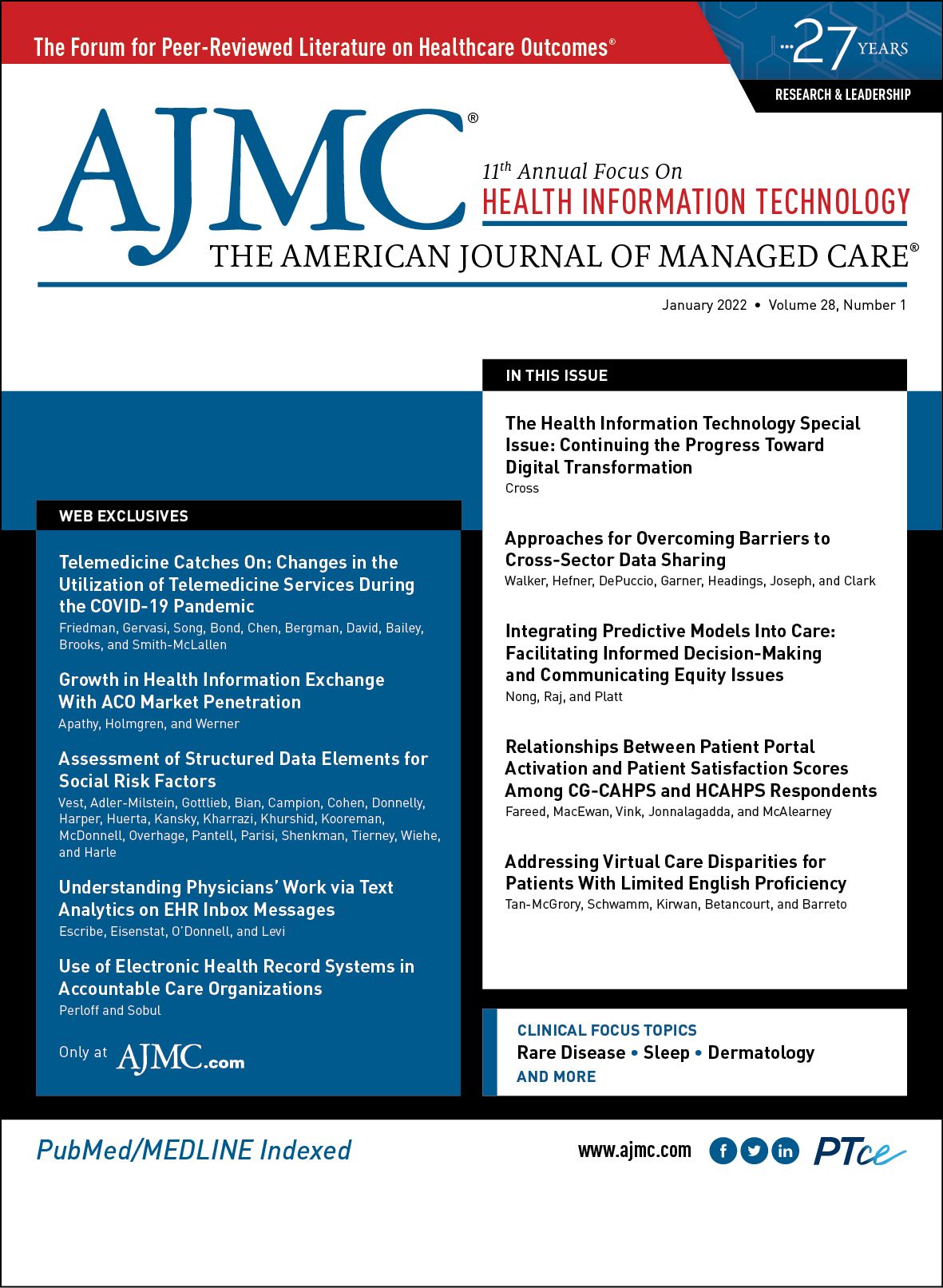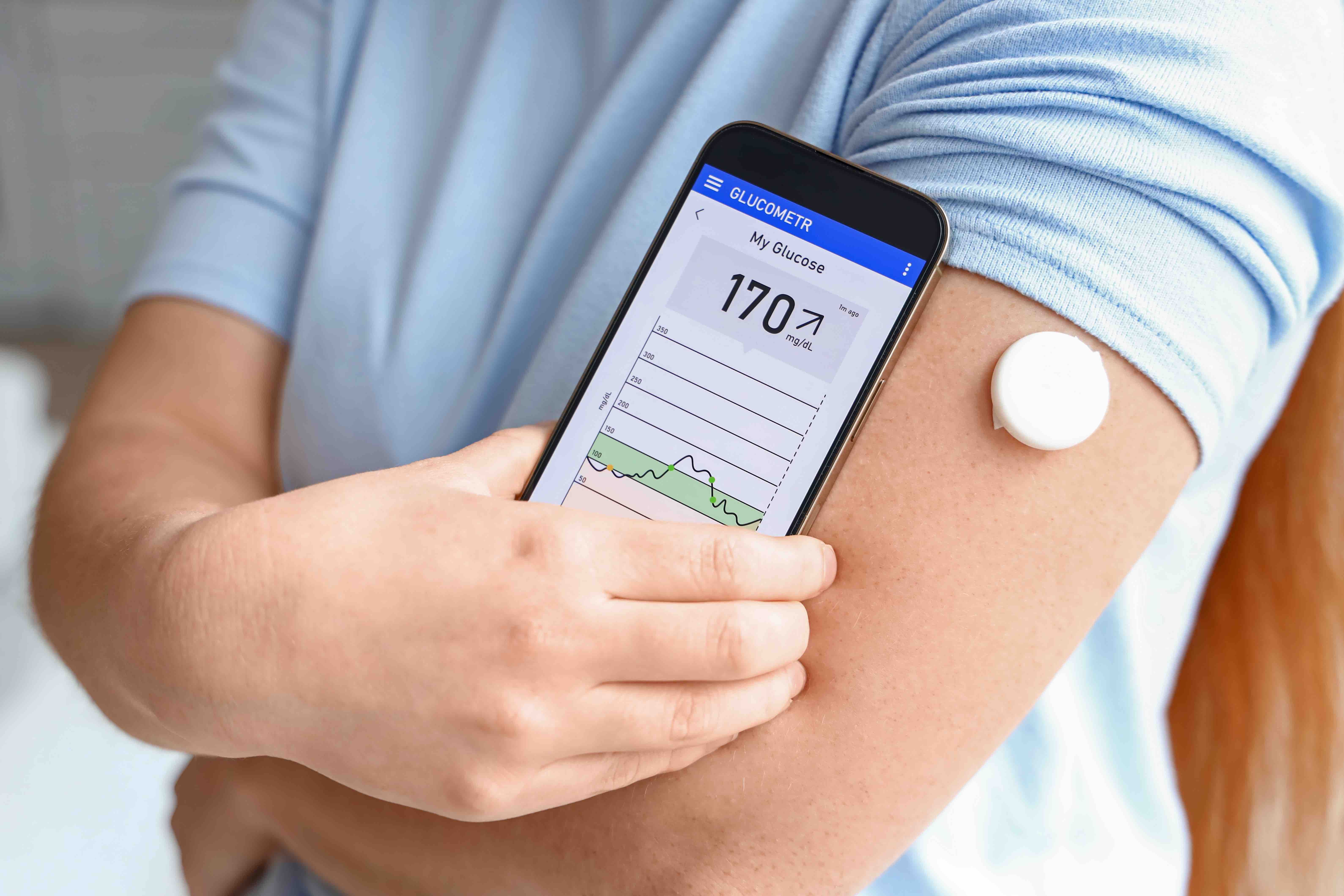Publication
Article
The American Journal of Managed Care
Telemedicine Catches On: Changes in the Utilization of Telemedicine Services During the COVID-19 Pandemic
Author(s):
This analysis of health insurance claims data demonstrates rapid increase and sustained high utilization of telemedicine services during the COVID-19 pandemic.
ABSTRACT
Objectives: To determine the degree of telemedicine expansion overall and across patient subpopulations and diagnoses. We hypothesized that telemedicine visits would increase substantially due to the need for continuity of care despite the disruptive effects of COVID-19.
Study Design: A retrospective study of health insurance claims for telemedicine visits from January 1, 2018, through March 10, 2020 (prepandemic period), and March 11, 2020, through October 31, 2020 (pandemic period).
Methods: We analyzed claims from 1,589,777 telemedicine visits that were submitted to Independence Blue Cross (Independence) from telemedicine-only providers and providers who traditionally deliver care in person. The primary exposure was the combination of individual behavior changes, state stay-at-home orders, and the Independence expansion of billing policies for telemedicine. The comparison population consisted of telemedicine visits in the prepandemic period.
Results: Telemedicine increased rapidly from a mean (SD) of 773 (155) weekly visits in prepandemic 2020 to 45,632 (19,937) weekly visits in the pandemic period. During the pandemic period, a greater proportion of telemedicine users were older, had Medicare Advantage insurance plans, had existing chronic conditions, or resided in predominantly non-Hispanic Black or African American Census tracts compared with during the prepandemic period. A significant increase in telemedicine claims containing a mental health–related diagnosis was observed.
Conclusions: Telemedicine expanded rapidly during the COVID-19 pandemic across a broad range of clinical conditions and demographics. Although levels declined later in 2020, telemedicine utilization remained markedly higher than 2019 and 2018 levels. Trends suggest that telemedicine will likely play a key role in postpandemic care delivery.
Am J Manag Care. 2021;28(1):e1-e6. https://doi.org/10.37765/ajmc.2022.88771
Takeaway Points
Telemedicine is a solution for providing medical care while preventing risk of COVID-19 transmission. Despite pulling back from its initial peak following regional stay-at-home orders, utilization remains high. This increase may spur broader adoption of telemedicine post pandemic.
- Weekly telemedicine visits for one insurer increased from a mean of 773 in 2020 prior to stay-at-home orders to 45,632 in subsequent weeks.
- Patients who were older, had existing chronic conditions, were male, or resided in predominantly non-Hispanic Black or African American Census tracts showed increased telemedicine utilization in later weeks of the pandemic. Mental health–related diagnosis codes experienced the greatest telemedicine increase of any clinical category.
As COVID-19 spread globally, health care delivery was forced into a period of rapid transformation. Telemedicine—the provision of health care visits through telephone, video conferencing, or electronic messaging—has historically faced adoption barriers, including patient and insurer acceptance.1 Telemedicine’s suitability for delivering care while promoting social distancing to slow disease transmission2 has led to significant changes by stakeholders. In late February 2020, the CDC recommended that providers move to remote visits.3 On March 13, Independence Blue Cross (Independence) announced that telemedicine visits across a wide range of services would be eligible for reimbursement. Four days later, federal changes allowed reimbursement for Medicare beneficiaries’ telemedicine visits4 and the use of noncertified communications applications, such as Zoom and FaceTime, without fear of Health Insurance Portability and Accountability Act enforcement.5 These significant changes to telemedicine policy, along with state stay-at-home orders and shifts in provider and patient behavior to reduce the likelihood of viral transmission and prioritize the care of vulnerable patients, facilitated the expansion and adoption of telemedicine.
Early evidence from ambulatory practices shows that telemedicine visits have been increasing at insufficient levels to offset declines in in-person visits.6-8 However, there has been limited investigation into whether disparities in receipt of telemedicine across age, race, ethnicity, socioeconomic status, and rurality extend into this new wave of unplanned telemedicine expansion.9,10 Our work extends these findings by also including telemedicine-only providers, examining demographics at a finer geographic scale (US Census tract), and extending the study period.
To better understand the utilization of telemedicine services across diagnoses and patient characteristics, we analyzed data from Independence, a large health plan based in southeast Pennsylvania.
METHODS
Data Sources and Population
We analyze the “prepandemic period” (January 1, 2018, through March 10, 2020) and the “pandemic period” (March 11, 2020, through October 31, 2020). For simplicity, because prepandemic trends in 2020 were similar to 2018 and 2019 trends, where indicated in the text and exhibits, certain analyses use “prepandemic 2020” (January 1, 2020, through March 10, 2020) for their comparison group. Deidentified summary data derived from medical claims and eligibility files were provided by Independence. A majority of Independence members who used telemedicine throughout the study period were from the 5-county southeast Pennsylvania region (Philadelphia, Chester, Montgomery, Bucks, and Delaware counties); approximately 40% of telemedicine-utilizing members were nationally distributed. Telemedicine visits were identified using service type and place of service codes, Healthcare Common Procedure Coding System procedural codes, and procedure modifiers (“95,” “GQ,” and “GT”). For comparison, we also identified nontelemedicine primary care provider and specialist office visits in 2020. Comparative specialist visit counts were restricted to those with associated specialty codes that were also represented in telemedicine claims for the same period. That is, we did not consider any specialist office visits for services that were not also provided via telemedicine. Demographic characteristics including age, sex, and line of business came from member enrollment files. Race and ethnicity information came from the US Census Bureau’s 2018 American Community Survey 5-year aggregate Census tract–level files. Chronic condition indicators for members were derived based on claims records and using CMS condition algorithms.11
A visit was defined as a unique combination of claim identifier, service date, member identifier, and provider. Multiple claims for a given member from the same provider on the same day were counted as a single claim. We included all claims incurred and posted by October 31, 2020. To avoid bias due to availability of claims-based chronic condition and behavioral health indicators, member demographic analyses (but not visit-level analyses) were restricted to members continuously enrolled for at least 6 months.
Clinical Data
The primary International Classification of Diseases, Tenth Revision, Clinical Modification (ICD-10-CM) diagnosis codes reported by service providers on telemedicine claims were aggregated into 20 clinically meaningful categories by body system using the Healthcare Cost and Utilization Project Clinical Classifications Software Refined (CCSR) for the ICD-10-CM–coded diagnoses.12 CMS’ chronic condition criteria based on diagnosis codes and sites of care were used to identify chronic conditions.13
Statistical Analysis
95% CIs of the difference in proportions compared the prepandemic and pandemic periods. Data were analyzed in R version 3.5.1 (R Foundation for Statistical Computing).
RESULTS
We analyzed 1,589,777 telemedicine visits from 624,236 unique members between January 1, 2018, and October 31, 2020.
Telemedicine utilization gradually increased over 2018 and 2019 but remained low through prepandemic 2020 compared with the pandemic period (Figure 1). In prepandemic 2020 from January 1, 2020, through March 10, 2020, there was a mean (SD) of 773 (155) weekly telemedicine visits. In the pandemic period, weekly visits averaged 45,632 (SD = 19,937). Beginning in week 11 of 2020, which begins March 11, 2020, and marks the first week of the pandemic period, visits rose rapidly, from 1151 in week 10 to 6980, 35,160, and 57,104 in weeks 11 to 13 of 2020, respectively, to a peak of 76,186 visits in week 17 (which begins April 22, 2020). By comparison, analogous specialist in-person visits fell from 151,709 in week 10 of 2020 to 35,914 in week 15, before partially recovering to 101,982 in week 40 (eAppendix Figure [available at ajmc.com]). Primary care in-person visits fell from 81,457 in week 10 of 2020 to 14,943 in week 15, before recovering to 63,744 in week 40 (eAppendix Figure).
The Table compares demographic characteristics of distinct telemedicine users in prepandemic 2020 vs the pandemic period. A greater proportion of telemedicine users were in the age group 65 years and older and in a Medicare Advantage plan in the pandemic period compared with prepandemic 2020. In the pandemic period, members living in rural locations represented a smaller overall percentage of distinct telemedicine users compared with nonrural users. Prepandemic, members residing in rural locations made up a slightly larger percentage of total telemedicine users. Members with previously diagnosed chronic conditions and hospitalizations in the past 6 months exhibited greater increases in telemedicine utilization during the pandemic period compared with those without. This trend was consistent across all types of chronic conditions but was largest among members with hypertension. Telemedicine use expanded in later periods to include US Census tracts with higher percentages of population with families living below the federal poverty line and among Census tracts with, on average, 2.8 percentage points higher proportions of their population identifying as non-Hispanic Black or African American.
Figure 2 depicts clinical categories assigned to primary diagnosis codes on all telemedicine visits occurring in prepandemic 2020 and the pandemic period. The largest average claim count increases were observed for telemedicine visits with a mental or behavioral health diagnosis category (212 to 16,151; 7418%) and for visits with a primary diagnosis of a respiratory disease category (235 to 2346; 798%), which were the only CCSR clinical diagnosis categories that contained more than 100 codes per week in weeks 1 to 10. In the pandemic period, 14% of mental/behavioral telemedicine visits from members with at least 6 months of continuous enrollment were from members with no 6-month history of any behavioral health condition.
DISCUSSION
Using claims data from a large insurer, we demonstrate that telemedicine expanded dramatically during the COVID-19 pandemic, similar to other findings.9 Contrary to prepandemic research,14 we found marked increases in use of telemedicine among older members in particular. Independence’s inclusion of telephone (ie, audio only) visits in the initial announcement may have increased accessibility to services, but other insurers whose policies with regard to audio-only visits were not described also showed increased telemedicine use among older adults.9 In an academic health system, Black and non–privately insured patients (Medicare, Medicaid, and self-pay) were more likely to use the telephone compared with video teleconferencing for telemedicine visits.15
Telemedicine visits increased more among members with chronic conditions. This may reflect recognition of the need for careful care coordination among members’ regular providers, particularly for management-intensive high-risk chronic diseases such as chronic kidney disease, chronic obstructive pulmonary disease, heart failure, and diabetes. Telemedicine visits for these members may have prevented exacerbations, potentially saving hospital capacity and lives. Telemedicine claims with an asthma diagnosis increased slightly from a high baseline in the earlier period, consistent with prepandemic telemedicine being used for general respiratory complaints. Telemedicine claims for hypertension also increased significantly, possibly because some aspects of hypertension management can be readily achieved with telemedicine.
Telemedicine use increased in a similarly high-risk group of patients: those with 1 or more inpatient hospitalization(s) in the past 6 months. Future research should evaluate whether these additional telemedicine visits added value by reducing readmissions among the recently hospitalized.
Following stay-at-home orders in March 2020, telemedicine use increased among members residing in predominantly non-Hispanic Black or African American Census tracts. This may be at least partially driven by an increase in the percent of Philadelphia County residents using telemedicine in 2020. From January to October 2020, 20% of distinct members with at least 1 telemedicine claim resided in Philadelphia County, which is more racially diverse than surrounding southeastern Pennsylvania counties. Before January 2020, only 7.2% of distinct members with at least 1 telemedicine claim resided in Philadelphia County. COVID-19 has brought to the forefront stark racial disparities that exist in the health care system. Higher rates of infection, hospitalization, and death have occurred in Black, Hispanic, and Asian populations compared with White populations.16,17 Telemedicine could represent a health care approach to improve access to primary and specialty care and provide timely and potentially lower-cost engagement with providers, both for COVID-19–related and other care needs. Future work should follow access to telemedicine for minority populations among both telemedicine and nontelemedicine users to identify disparities and ensure that the gains we document persist if some prepandemic restrictions on telemedicine return.
Telemedicine claims with diagnosis codes related to mental/behavioral health showed the greatest increase during the first wave of the COVID-19 pandemic, followed by diagnosis codes grouping to other signs and symptoms and codes grouping to the musculoskeletal and endocrine categories. These visits may be particularly amenable to telemedicine. In addition, early evidence indicates that the stress of the pandemic may have caused acute mental health needs.18
Limitations
We use claims data to gain a global, rather than health system–specific, view of the transition to telemedicine among the insured population. However, we could not investigate those who are uninsured, are insured through Medicaid or traditional Medicare or nonbilled activities, or did not appear in Independence claims records for the period of study. Patients calling public information lines, calling health systems, or discussing their symptoms with clinician-backed online chatbots are not included in our study. We also do not know the medical need among each group nor whether telemedicine addressed acute or preventive needs; older or chronically ill members might have derived additional benefit from an even greater increase in telemedicine. We did not assess variation in member access to communications technologies such as broadband internet or devices such as a computer, tablet, or cell phone, which can influence whether and how telemedicine services are used. Finally, data describing changes in telemedicine use across race and ethnicity groups are presented at the Census tract level according to the US Office of Management and Budget standards on race and ethnicity aggregations, and they should be considered only a proxy for changes occurring among individual members. Further work is needed to investigate the interactions of race, social determinants of health, uptake and continued use of telemedicine, and the effects on health outcomes.
CONCLUSIONS
The unprecedented scope of telemedicine’s adoption among Independence members likely accelerated the uptake of this new model of care by several years.19 Many providers have overcome the fixed costs of implementing telemedicine platforms and learned to deliver care without a hands-on exam. Relaxing prepandemic technical requirements for telemedicine visits has made telemedicine accessible to populations less versed in technology. Hundreds of thousands of patients of all ages and backgrounds have now experienced clinician visits without the transportation costs and waiting time of a typical in-person visit. Future telemedicine use may not resemble the current surge, but reversion to the former low levels of adoption is unlikely, as the ongoing level of telemedicine utilization demonstrates. As the future of telemedicine evolves, continued research into adoption trends, health outcomes, and patient and provider satisfaction will be needed to set policy and guidelines for safe and effective use of this technology.
Acknowledgments
Ari B. Friedman, MD, PhD, and Stephanie Gervasi, PhD, contributed equally to this work and are listed as co–first authors. Dan Ellis, Priyanka Nandyala, and Samantha Cruz provided assistance in understanding and analyzing telemedicine claims, and Alya Nadji provided valuable comments on an earlier draft of this manuscript. Patients or the public were not involved in the design, or conduct, or reporting, or dissemination plans of our research, but we plan to disseminate these results through this publication and through the lay press where applicable. Due to enrollee privacy concerns, these data are not available to be shared for reanalysis. This manuscript represents a deidentified analysis of routinely collected data and therefore is exempt from human subject review.
Author Affiliations: Perelman School of Medicine (ABF, ATC), Leonard Davis Institute of Health Economics (ABF, HS, ATC, AB, GD), and The Wharton School (HS, AB, GD), University of Pennsylvania, Philadelphia, PA; Independence Blue Cross (SG, JMB, RB, AS-M), Philadelphia, PA; Weill Cornell Medical College (AMB),New York, NY.
Source of Funding: None.
Author Disclosures: Dr Gervasi, Ms Bailey, and Dr Smith-McLallen are employed by Independence Blue Cross. Dr Brooks is a board member of Holy Redeemer Health System and is employed by Independence Blue Cross. The remaining authors report no relationship or financial interest with any entity that would pose a conflict of interest with the subject matter of this article.
Authorship Information: Concept and design (ABF, SG, HS, AMB, ATC, AB, GD, JMB, RB, AS-M); acquisition of data (ABF, SG, HS, JMB, RB, AS-M); analysis and interpretation of data (ABF, SG, HS, AMB AB, GD, JMB, RB, AS-M); drafting of the manuscript (ABF, SG, HS, ATC, AB, GD, JMB, RB, AS-M); critical revision of the manuscript for important intellectual content (ABF, SG, HS, AMB, ATC, GD, JMB, RB, AS-M); statistical analysis (ABF, SG, RB); provision of patients or study materials (SG, JMB, RB, AS-M); administrative, technical, or logistic support (SG, JMB, RB, AS-M); and supervision (ABF, SG, HS, GD, RB, AS-M).
Address Correspondence to: Ari B. Friedman, MD, PhD, Perelman School of Medicine, University of Pennsylvania, 3400 Civic Center Blvd, Philadelphia, PA 19104. Email: arib@alumni.upenn.edu.
REFERENCES
1. LeRouge C, Garfield MJ. Crossing the telemedicine chasm: have the U.S. barriers to widespread adoption of telemedicine been significantly reduced? Int J Environ Res Public Health. 2013;10(12):6472-6484. doi:10.3390/ijerph10126472
2. Hollander JE, Carr BG. Virtually perfect? telemedicine for Covid-19. N Engl J Med. 2020;382(18):1679-1681. doi:10.1056/NEJMp2003539
3. Managing healthcare operations during COVID-19. CDC. February 8, 2021. Accessed August 18, 2021. https://www.cdc.gov/coronavirus/2019-ncov/hcp/facility-planning-operations.html
4. Medicare telemedicine health care provider fact sheet. CMS. March 17, 2020. Accessed May 29, 2020. https://www.cms.gov/newsroom/fact-sheets/medicare-telemedicine-health-care-provider-fact-sheet
5. OCR announces notification of enforcement discretion for telehealth remote communications during the COVID-19 nationwide public health emergency. HHS. March 17, 2020. Accessed May 29, 2020. https://www.hhs.gov/about/news/2020/03/17/ocr-announces-notification-of-enforcement-discretion-for-telehealth-remote-communications-during-the-covid-19.html
6. Mehrotra A, Chernew M, Linetsky D, Hatch H, Cutler D. The impact of the COVID-19 pandemic on outpatient visits: a rebound emerges. The Commonwealth Fund. May 19, 2020. Accessed May 29, 2020. https://www.commonwealthfund.org/publications/2020/apr/impact-covid-19-outpatient-visits
7. Patel SY, Mehrotra A, Huskamp HA, Uscher-Pines L, Ganguli I, Barnett ML. Trends in outpatient care delivery and telemedicine during the COVID-19 pandemic in the US. JAMA Intern Med. 2021;181(3):388-391. doi:10.1001/jamainternmed.2020.5928
8. Cantor JH, McBain RK, Pera MF, Bravata DM, Whaley CM. Who is (and is not) receiving telemedicine care during the COVID-19 pandemic. Am J Prev Med. Published online March 6, 2021. doi:10.1016/j.amepre.2021.01.030
9. Patel SY, Mehrotra A, Huskamp HA, Uscher-Pines L, Ganguli I, Barnett ML. Variation in telemedicine use and outpatient care during the COVID-19 pandemic in the United States. Health Aff (Millwood). 2021;40(2):349-358. doi:10.1377/hlthaff.2020.01786
10. Patel SY, Rose S, Barnett ML, Huskamp HA, Uscher-Pines L, Mehrotra A. Community factors associated with telemedicine use during the COVID-19 pandemic. JAMA Netw Open. 2021;4(5):e2110330. doi:10.1001/jamanetworkopen.2021.10330
11. Condition categories. Chronic Conditions Data Warehouse. Accessed May 1, 2021. https://www2.ccwdata.org/web/guest/condition-categories
12. Clinical Classifications Software Refined (CCSR). Agency for Healthcare Research and Quality. Accessed May 29, 2020. https://www.hcup-us.ahrq.gov/toolssoftware/ccsr/ccs_refined.jsp
13. Chronic conditions. CMS. Accessed May 6, 2021. https://www.cms.gov/Research-Statistics-Data-and-Systems/Statistics-Trends-and-Reports/Chronic-Conditions/CC_Main
14. Walker DM, Hefner JL, Fareed N, Huerta TR, McAlearney AS. Exploring the digital divide: age and race disparities in use of an inpatient portal. Telemed J E Health. 2020;26(5):603-613. doi:10.1089/tmj.2019.0065
15. Drake C, Lian T, Cameron B, Medynskaya K, Bosworth HB, Shah K. Understanding telemedicine’s “new normal”: variations in telemedicine use by specialty line and patient demographics. Telemed J E Health. Published online March 25, 2021. doi:10.1089/tmj.2021.0041
16. CDC, Washington state report first COVID-19 death. News release. CDC. March 1, 2020. Accessed May 29, 2020. https://www.cdc.gov/media/releases/2020/s0229-COVID-19-first-death.html
17. Rubin-Miller L, Alban C, Artiga S, Sullivan S. COVID-19 racial disparities in testing, infection, hospitalization, and death: analysis of Epic patient data. Kaiser Family Foundation. September 16, 2020. Accessed May 4, 2021. https://www.kff.org/coronavirus-covid-19/issue-brief/covid-19-racial-disparities-testing-infection-hospitalization-death-analysis-epic-patient-data/
18. Ayers JW, Leas EC, Johnson DC, et al. Internet searches for acute anxiety during the early stages of the COVID-19 pandemic. JAMA Intern Med. 2020;180(12):1706-1707. doi:10.1001/jamainternmed.2020.3305
19. Barnett ML. After the pandemic, visiting the doctor will never be the same. and that’s fine. Washington Post. May 11, 2020. Accessed May 29, 2020. https://www.washingtonpost.com/opinions/2020/05/11/after-pandemic-visiting-doctor-will-never-be-same-thats-fine/







